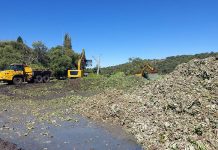Chile is South Africa’s main southern hemisphere competitor in fruit exports, says Conradie, the product manager for stone and pome fruit at the Deciduous Fruit Producer’s Trust (DFPT). He’s conducting a comparative study of apple and pear production in Chile and Africa.
In the 2006 and 2007 season, Chile was the biggest southern hemisphere apple exporter with 735 126t, New Zealand was second with 292 869t and SA was third with 272 598t. Chile was the third-largest pear exporter with 112 354t, while was second with 138 321t. Chile ranked number one as the most competitive apple- and pear-producing country in the world, with SA 11th for apples and 12th for pears, according to data supplied by the DFPT.
Equipped for the market
solated by the Andes Mountains in the East and the Atlantic in the West, Chile is a phytosanitary island with almost no naturally occurring plagues or viruses. According to Conradie, the country has excellent fruit producing conditions, with fertile soil and the right climate, as well as an abundant water supply from the snow-capped Andes. In comparison, SA has poor natural resources with relatively poor soil and limited water resources, and global climate change is expected to hurt our apple and pear industry.
According to Dr Mohammad Karaan, an agricultural economist at the University of Stellenbosch, Chile and the rest of America – rather than Australia – are our real competitors for future growth and market access in the deciduous fruit industry.
“Australia is experiencing its worst drought ever, making agriculture unpredictable and risky,” he says, “Chile has recently managed to attract huge foreign investment, enabling them to develop their mining and agriculture industries.
“Like SA, Chile is a young democracy, also with a violent past,” says Dr Karaan. “It has performed impressively for such a small and isolated country.
He says that due to the resulting huge inflow of capital, the Chilean peso is currently too strong for favourable international trade. The US is one of Chile’s biggest export markets and any devaluation in the currency is bad news for it, so there are reasons for concern for its immediate future.
SA’s currency, on the other hand, is devaluing against all major international currencies, making our exports more competitive and giving us an advantage over Chile. Dr Karaan believes the SA industry should use this opportunity to regain ground lost to Chile over the past 10 years.
South Africa’s market potential
“Chile has signed free trade agreements with Canada, Central American nations, the European Free Trade Association, Mexico and the US,” says Conradie. “Recently it signed free trade agreements with the EU, South Korea, Zealand, Singapore, Brunei and China and it’s currently in negotiation with India and Japan.”
n particular, the agreement with China can boost Chile’s job creation and long-term economic growth. More agreements with other major Eastern markets are expected to follow.
A, on the other hand, has only two free trade agreements, one with the EU and another with the Southern African Development Community (SADC), says Conradie. “Forget the SADC,” says Dr Karaan. He believes we keep on compromising ourselves when dealing with this organisation. The trade benefits go to other countries with no real benefits for SA.
SA also has preferential agreements with Malawi, Zimbabwe and Croatia, and we are in the process of negotiating possible free trade agreements with India and China, says Conradie.Conradie says that, “While the terms of such a pact with China remain undefined, there is broad concern about the possible detrimental longer-term effect such an agreement might hold for African economies.”
The biggest bite
Dr Karaan says Chile has effectively been usurping markets that were traditionally ours. This has been done through two organisations, the Foundation Chile and the Chilean Exporters Association (ASOEX).
Foundation Chile is a semi-state organisation that develops technology and sources investment to grow industry in Chile. Strong state incentives are available and the foundation gathers and uses market intelligence in different industries. ASOEX is a private industry organisation that coordinates and markets 90% of all fruit exports from Chile.
Dr Karaan believes that ASOEX has more advanced market intelligence than SA industry bodies. Conradie agrees, stressing that market intelligence used to be a huge problem in SA, and that his organisation has been working on that for over 18 months.
“Our exporters now get real time information from the electronic data flow project undertaken by the pome, stone and citrus industries,” he says. “Weekly shipping and inspection information is now available to exporters and growers on industry websites and reports are distributed via e-mail.”
However, Dr Karaan says it would be unrealistic to expect the current SA government to establish and drive initiatives and bodies similar to those of Chile.“Agriculture doesn’t enjoy the same priority in SA and the government must prioritise assistance to BEE projects,” he says. “Established, successful industries such as the fruit export industry must take the initiative.”
Defining limitations
Fruit export is a major component of Chile’s GDP, but that is not the case in South Africa. Conradie says the Chilean economy is simpler in the sense that it has only two major components – agriculture and mining. When negotiating for free-trade agreements, It doesn’t have to think about protecting a vulnerable grain or textile industry.
Conradie says that Chile is not well-situated for the European market, as shipping takes three to four weeks. Its shipping infrastructure is also under pressure due to rising apple and pear export volumes.Dr Karaan and Conradie believe that SA should focus on the Middle East, and parts of Asia where we would have the advantage of shorter shipping routes.
Another market to consider is Iran, with a population of 70 million people and very good infrastructure due to oil money. After China, the Middle East is where most international investment money is currently being spent. Current oil prices have set those countries up for huge investment and economic growth.
Product realities
In markets where SA competes head-on with Chile, such as in the UK and EU, there are positive and negative aspects to consider. Chile’s apples and pears are bigger, but ours have a longer shelf life and are generally of a better eating quality. Further, Chile tends to focus on marketing at trade level. SA should use this as an opportunity to target the consumer directly.“It is high time our industries worked together to build the image of the SA brand in our existing and potential export markets,” says Conradie.Contact Stefan Conradie on (021) 870 2953 or Dr Mohammad Karaan on (021) 808 4759. |fw








